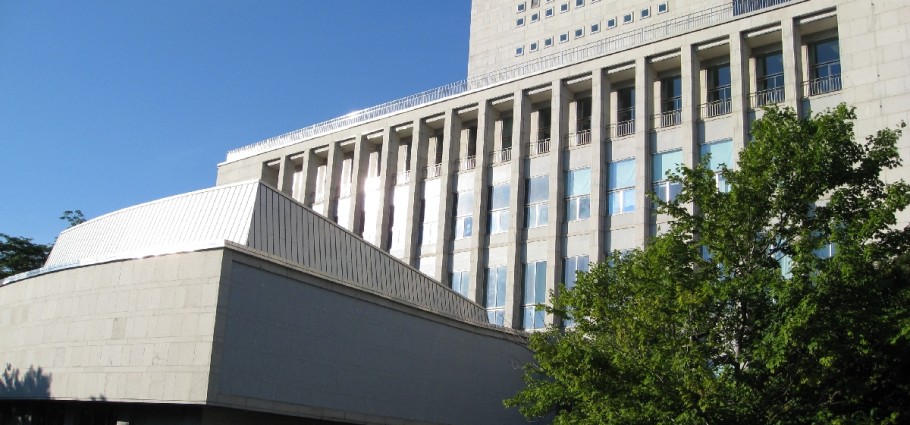
Editor’s note: This article is cross-posted from Spacing Ottawa contributor Chris Warden’s new website dedicated to modernist architecture in Ottawa. As Chris explains, Capital Modern‘s inspiration is “a concern with the lack of value that is typically attributed to buildings and sites from this period in Ottawa’s growth as a city…[the] site is meant to fit into the growing attention this period is receiving and to provide a wide audience with the opportunity to consider and/or reconsider works from this period.”
One of the key legacies of the Centennial celebrations in Ottawa was the construction of numerous public institutions aimed at promoting and protecting the collective memory and identity of Canada and its peoples. Perched at the western edge of the Parliamentary Precinct, the Library and Archives Canada building is a modernist landmark serving the role of providing storage for important documentation, providing access to this documentation and being a site for public use. In fact public use of the building is identified in the building’s Heritage Character Statement: “as an important public venue in Ottawa”. A heritage character statement, prepared by FHBRO (Federal Heritage Building Review Office) is a summary document that outlines key architectural, associative and cultural characteristics that define a building’s heritage value. The provision of gracious public spaces, significant artwork specifically designed for the building, an auditorium and other gathering spaces within the building all support the public functions and intent inherent in the original design and integral to the character of the building. Over the intervening years since its construction finished in 1967 the building and its public spaces have been incredibly well used by the citizens of the Capital Region. With the apparent shift in Government policy and addition of further procedural requirements it will be much more difficult to access this important public space (one of the few at this end of Wellington Street) and its usefulness as an indoor gathering space place within downtown Ottawa.
One can only hope that the current shift in policy will be revisited when many of the planned or currently underway projects to address required renovations on Parliament Hill are completed. However, it will be some time before all of those renovations are complete, perhaps decades. The loss of easy public access to the space is also compounded by the loss of the Lorne Building and its auditorium on Elgin Street downtown. This leaves the variety of spaces at Ottawa City Hall and the Ottawa Public Library (OPL) auditorium, Arts Court (subject of a renovation proposal) and other smaller venues available for use. However, many of these spaces are well used and likely cannot accommodate the increased demand.
There are always opportunities that arise from challenges and one such opportunity is just mere blocks from the Archives. Hiding within the Podium Building at Place du Ville is a piggy-back 2 cinema complex that has been closed since 1996. While much of the interior elements have been removed for some time, the shell remains intact. It is waiting to accommodate a new use. These empty cinemas are not perfect, but do offer potential to serve a function well beyond how they have been used over the past fifteen years. That being said numerous upgrades would be required to accommodate a new use, especially over the longer term. As such it would not be replacement that could be brought on line quickly, but could be part of a longer term strategy for providing public gathering space in the city.
Then there is the issue of who would pay for such a renovation or similar facility which yields no easy answers and provides additional questions. The most fundamental of these is what is the relationship between “Town” and “Crown” and how should it manifest itself in the built fabric and public space of Ottawa? A complicating factor in this is the current regional politics that appear to run counter to the collective representation and experience that capital cities typically possess.{what does this mean exactly?} That being said it affords the opportunity to evaluate how we approach public gathering spaces in Ottawa. This will undoubtedly take time to address, but is a well-placed notion, given the ongoing discussions surrounding the potential new central branch for the OPL. It is an important evaluation to consider, given the current Federal Government approach to public space in Ottawa to determine a more diverse approach to providing public gathering spaces, and to reduce the impact of policy shifts that may continue to occur. The tension between Town and Crown is a constant in Ottawa and its impact on the public realm needs to be carefully considered.
